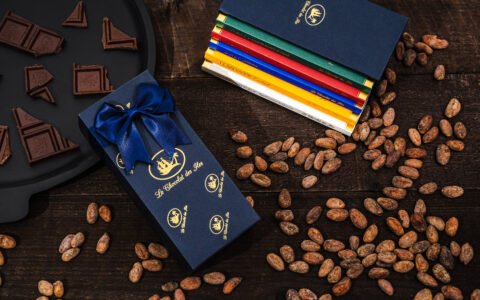
The Journey of Cacao: From Bean to Bar
Have you ever wondered what cacao beans go through before it becomes a delicious chocolate bar? Our blog explores the making process of dark chocolate, taking you on a journey of discovery. We’ll start with the cacao tree, the source of all chocolate, and follow the journey of cacao from bean to bar.
Cacao harvesting
Cacao trees grow in tropical places like Mexico, Ecuador, and Papua New Guinea. This harvesting process happens twice a year, from November to January and May to July. A creamy white mucilage covers the cacao beans in the pods. Afterward, you remove the beans from the pulp and process them into chocolate. It’s amazing to think about all the care and effort that goes into producing each and every chocolate bar we enjoy
Testing the cacao beans
At Le Chocolat des Iles, we first receive samples of cacao beans at our testing lab. We then carefully evaluate their flavor through a tough testing process. Unfortunately, many of the samples end up not meeting our high standards, and we have to reject them. This can be disappointing for some farmers, but we always pay them well for their efforts.
Once we’ve chosen the best samples, we place orders with the cooperatives and keep track of the beans’ journey until they arrive in the US. When the beans finally make it to our facility, we sort them thoroughly to make sure they’re pure and high quality. This makes our chocolate have a rich flavor and aroma.
Fermentation process
Cocoa beans go through a fermentation process to develop their natural flavors, which is the first critical step in chocolate-making. Cocoa pods contain 30 to 40 seeds surrounded by fibrous white pulp that ferments when exposed to air. You scoop the beans out and ferment them in large boxes with holes. This can take up to 8 days and reach temperatures of 45-50°C.
The cacao fermentation process converts the pulp into alcohol and is fueled by ambient microbes. This heat also halts the germination process of the beans. The principal effect of the cacao fermentation process is to transform the flavor of the beans to what we associate with cocoa and chocolate.
Cacao drying and roasting
To begin the process, we roast the beans at a specific temperature that helps preserve their natural flavor. However, even after fermentation, the beans still have too much water content to turn them into chocolate. So we spread them out in the sun to dry for up to two weeks. Once they’re dry, we carefully inspect and sort them.
Then comes the crucial step of roasting the beans. You heat them to 210°F for 10 to 15 minutes. This sterilizes them and enhances their flavor. After roasting, the next step is much easier.
Refining process
After roasting, we use a special machine, designed and manufactured to our specific requirements to crack the beans. In fact, all the machines we use during the refining process are either built by our founder or tailored to our unique specifications.
When the beans crack, we proceed with separating the husk from the nibs in two stages.
Conching and tempering
After the cracking process, the cocoa beans go into our special conch machine. The conching process takes up to 12 hours, and it’s a crucial step in the manufacturing process. Once this process is complete, we’re ready to move on to tempering the cocoa liquor, which is necessary to create chocolate bars.
At this stage, we either solidify the cocoa liquor into 20 kg blocks or keep it in a melted state in a holding tank. You do this to prepare it for the tempering process, which is the final step before we can deposit the chocolate into bars.
Molding chocolate
After tempering, the liquid chocolate is sent to a depositing line where it’s molded into the shape of chocolate bars. Then, you cool the molds in a tunnel, allowing the chocolate to set. Finally, we remove the bars from the molds and package them up, ready to ship off to customers.
/*54745756836*/

